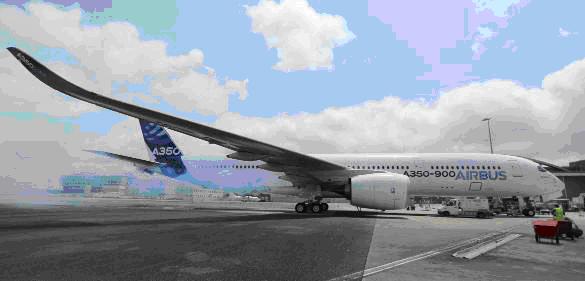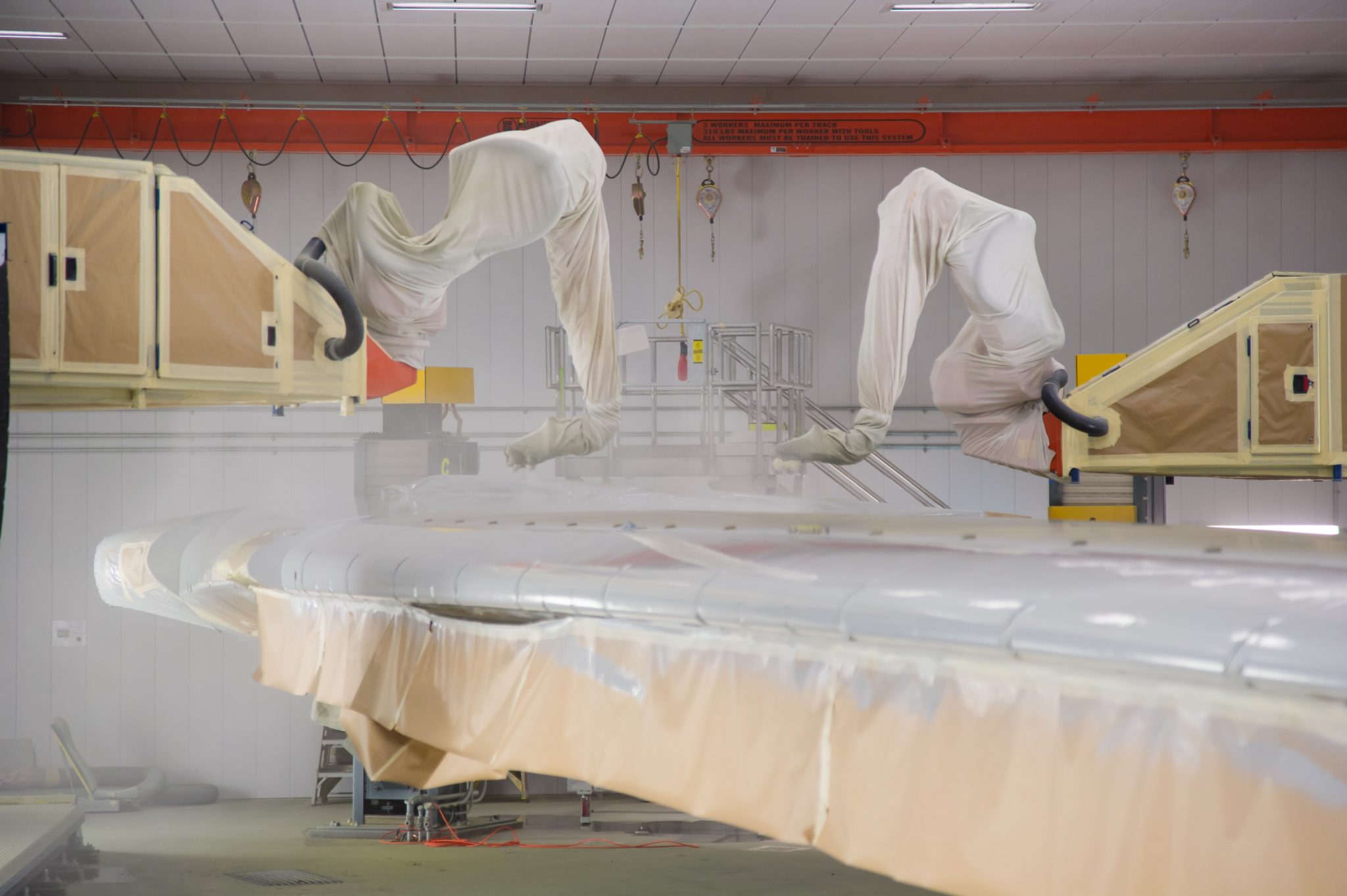Leeham News and Analysis
There's more to real news than a news release.
Leahy skeptical of Boeing plan to add 737 seats, vows to maintain 60% share of neo-MAX sector
Airbus’ chief operating officer-customers, John Leahy, dismisses the idea that Boeing can add more seats to its 737 family to gain competitiveness over the A320 family.
In a press briefing in advance of the air show discussing the 737 MAX (not subject to embargo), a Boeing official revealed that the company is considering changes to the galley/aft lavatory design and the use of slim line seats to add 6-9 seats to the entire 737 NG family. These changes would migrate to the 737 MAX. Airbus previously announced similar changes to the A320, gaining three seats, and more recently to the A321—which also required the addition of exit doors—to boost capacity to 236 passengers in shoe-horn configuration.
But in an interview with Leahy, was skeptical about Boeing’s possibilities.
“That’s more problematic, we’ll see,” he said. “Is this the O’Leary option where they stand at the back of the airplane?” he quipped, referring to Ryanair CEO Michael O’Leary, who has proposed a standing seat configuration.
“I’d be very surprised if they did that,” Leahy said, getting back on point. “I don’t know if they could do that (6-9 seats) but remember, we have 236 seats in the A321, so why should I be concerned if they squeeze a few extra seats in? I’d be surprised if they can. I think [the 737-900ER] is at its exit limits right now. It’s also at its performance limits.
Leahy believes that the A320neo will maintain a 60% market share vs the 737 MAX.
“We’re outselling the MAX 2-1 with a 65% market share. We’re not talking about the first couple of hundred airplanes, we’re talking about the first couple of thousand that the neo will have 60% of the market and they’ll have 40%. We’ll give them 40% of the market. It looks right now that the [neo] market will go higher than that but we’ll stay there.”
Wide-body airplanes get plenty of attention at IATA; Leahy comments on 777X, A350 and A380
The 69th AGM of IATA just concluded at Cape Town, South Africa, and wide-body aircraft drew a lot of focus in these articles from Bloomberg News and Reuters.
We spoke with John Leahy at the end of the AGM, and though tired and off to sell more airplanes before the Paris Air Show begins June 17, he had some pithy comments about Boeing’s 777X and a strong defense of the A380 sales.
Boeing will have a public briefing of the 777X at the air show, but there have been plenty of leaks before now in which the 777-9X is said to be 20% more fuel efficient than the 777-300ER it’s conceived to replace.
“Be careful with the numbers there,” Leahy said, referring to the 20% figure. “We’re not at all worried about the 777X. They are known for their paper airplanes. No one seems to remember that they already not just marketed but sold 777-200s with folding wings, and of course none was produced. No one seems to remember the ‘game-changing’ Sonic Cruiser, which of course was a joke. No one seems to remember the 747-500, the 747-600 or the 787-3. The Japanese remember the 787-3, which [Boeing] sold with legally binding contracts and just never delivered.
“Yeah, they’re worried about the A350-1000, and they’ve come out with one paper airplane after another and declaring victory, declaring that the world is beating a path to their door. Naw. It’s BS. It’s typical Boeing marketing hype.”
As we remarked to Leahy, “tell us what you really think.”
Leahy repeated previous statements that he could sell a lot more A350-1000s if he had the production slots.
“We could substantially increase sales for the A350-1000 if we could substantially increase production. I need a second line, a dedicated line and we’re debating that internally. We’re doing the business case. I’m confident we can make that decision before the end of the year.”
We asked a leading question about the rate he’d like to see, but Leahy didn’t bite.
“I don’t want to tell Boeing exactly what we are up to.”
We also asked where the additional line would be, if approval is granted: France, Germany or Mobile (AL). “It’s not going to be Mobile,” he said. “Let’s start building CEOs and NEOs there first before we start getting into wide bodies.”
Although there have been a number of stories reporting that Japan Air Lines and All Nippon Airways may buy the A350-1000, breaking Boeing’s decades-long monopoly. It won’t be by Paris, apparently.
“I’d be very surprised, but I can say I’m looking for an improvement in our market share in Japan. We have nowhere to go but up. I would be hopeful we will get a breakthrough in Japan, but I don’t want to predict a timeline,” Leahy said.
A380 sales have been poor, but Leahy is sticking to his prediction of 25 sales this year.
Question: The A380 isn’t selling very well.
Leahy: Excuse me, I haven’t modified my forecast. I said I’ll sell 25 this year, and I’ll sell 25 this year. If this were December, maybe we’d have a discussion. I’ll sell 25 this year.
Q. You fell short last year.
Leahy: “Bad things happen to good people.”
Q. The VLA forecast 1200-1300 since 2000. Sales and delivery rates fell short every year to maintain that pace.
Leahy: “The one thing that doesn’t change is that [everybody] all agree[s] that RPKs double every 15 years. We have to have larger aircraft. Larger aircraft are the only solution [for key airports].”
The Airbus forecasts assumed Boeing would capture a 50% share of the VLA passenger market. In fact, Boeing only has a 10% share. Leahy predicts this split will be maintained.
“We will have 90% market share for VLA. The A380 will do very well and I am confident the book-to-bill will be maintained. No, we’re not going to sell 60-70 aircraft a year. But we will sell 25-35 and we will build 25-35 a year,” he said. “A380 do get high yield passengers.
Note: Because readers won’t behave, comments are closed.
Running on all cylinders and picking up speed at Boeing
Beginning in 2007 and for the next six years, it was trials and tribulations for The Boeing Co.
The 787 program was years late, billions of dollars over budget and the first commercial airliner produced by Boeing that was grounded.
The Queen of the Skies, the 747, has largely become morbid-bound in its latest iteration, which was also years late and well over budget.
The KC-767 International Tanker program became an embarrassment, also years late, over budget and beset by design issues. This program in disarray was weighed by the USAF as a risk factor that played a role in selecting the Northrop/EADS KC-330 in the first round of competition to recapitalize the KC-135 fleet.
In a huge embarrassment, Airbus skunked Boeing over the entire single-aisle re-engine vs new replacement issue, swept in an won a big order from American Airlines and forced Boeing into a highly awkward co-press conference to launch the MAX at American in which former BCA CEO Jim Albaugh looked like he had just swallowed four or five lemons.
It continued: The A320neo is far outselling the 737 MAX and Airbus has co-opted a number of previously exclusively Boeing customers.
Readers know we’ve been pretty hard on Boeing throughout many of these issues, and we’re inherently skeptical. So when we now conclude that Boeing at long, long last is back on track and picking up speed, we’re not simply sniffing kerosene.
737 MAX may share NG improvements still to come, which might include more seats
Boeing’s 737 MAX, still weeks away from design configuration freeze and still with lots of detailed design to come, may share improvements still to come on the current 737 NG.
The head of the MAX program, Keith Leverkuhn, vice president and general manager, wouldn’t confirm or deny a report by Aspire Aviation that the MAX family will have 6-9 more seats through interior changes, the use of slim line seats and door changes when asked during Boeing’s MAX briefing yesterday with an international crowd of journalists.
Citing unidentified Boeing sources, Aspire reported:
- Boeing to modify 737 MAX 8 doors to add around 9 seats;
- 737 MAX 8 to meet 13% fuel burn reduction per seat target after door modification;
- Door modification has negligible impact on MEW; and
- 737 MAX 7 & MAX 9 also likely to have around 9 more seats.
Leverkuhn told the media that Boeing was satisfied with the current configuration of the airframe of the NG and MAX shares this configuration. Although Leverkuhn said Boeing had no intentions of changing, it still would talk with customers–leading to the obvious conclusion that Boeing wasn’t saying a firm “no” to the possibility.
We talked with him a few minutes alone later in which he clarified his earlier comments. Leverkuhn told us that while there will be no changes to the doors on the MAX which would allow more seats, the NG program is considering interior configurations that could lead to more seats and the MAX and NG programs closely follow developments and determine what can be shared between NG improvements still to come and the final MAX design.
Airbus in January announced a space-flex program that includes two new doors, enabling high density capacity to grow to 236 from 220. Airbus previously began offering a revised aft galley/lav combination in the A320 to permit three more seats, to 153 in two-classes. Boeing has been studying similar changes, according to our market intelligence.
Odds and Ends: Airbus, Boeing trade barbs–again; Airbus raises order goals; first 787-10 commitment
More tit-for-tat: Airbus and Boeing are engaged again in their pointless trading of barbs. But it makes for entertaining reading.
Here’s what Boeing had to say. The relevant excerpt is from the Bloomberg report: Airbus doesn’t “have an airframe that can compete” with the 777X, the upgraded version of Boeing’s biggest twin-engine plane, Chief Executive Officer Jim McNerney said at an investor conference today. “They don’t have the appetite to do a ground-up airplane, and they’d have to do a ground-up airplane.”
Considering the 777X itself is a derivative, we find McNerney’s comment kind of snarky. But he is right that Airbus doesn’t have a competing airplane to the 777-9X.
Here’s what Airbus had to say. The relevant except is also from Bloomberg: “The aircraft we rolled out a couple of weeks ago didn’t have rivets from Wal-Mart, like the ones our competitors had at the time off their roll-out,” Tom Enders, the chief executive officer of Airbus parent European Aeronautic, Defence & Space Co., told investors at the annual shareholders meeting today. “It’s a real aircraft.”
Airbus raises order goal: Here’s the story.
First 787-10 Commitment: As we’ve long reported, Singapore Airlines will be a launch customer for the 787-10.
- We’ll be at Day 2 of the Boeing PAS briefing today. Everything is embargoed until June 14 except for the briefing on the 737 MAX, at 2pm PDT.
Watch this blog for live updates (on the assumption Boeing will give media access to the Internet at the time, which it did yesterday at a different location). - Well, Boeing didn’t have Internet access today for us. So much for the live updates. See a new post for this information.
Odds and Ends: 787 impact on Boeing; Pan Am Worldport follows the airline; KC-46A production
787 Impact on Boeing: Over at AirInsight, we write that the 787 grounding in the end has a small impact on Boeing. Find out why here.
Following Pan Am into oblivion: The famed Worldport will be demolished next year. Another piece of history will be gone, but our friend Benet Wilson thinks the demise is a good idea.
Speaking of history, did you realize Aloha Air Lines is still around, as Aloha Air Cargo?
KC-46A production begins: The Puget Sound Business Journal reports that production on the Boeing KC-46A USAF tanker begins shortly.
Plane Talking’s Air Show Preview: Ben Sandilands’ Plane Talking takes his look at the Paris Air Show preview today. Our Paris Air Show Preview will be coming next week. Tomorrow and Thursday we’re at Boeing all day for PAS briefings, all except program updates on the 737 MAX and today’s 777 under embargo until June 14 and the 2013 Current Market Outlook under embargo until June 11.
We’re particularly looking forward to the MAX briefing in light of the information linked yesterday to Daniel Tsang’s huge Boeing piece in which he touched on some MAX features.
Meantime, our colleague Addison Schonland will be going to the Airbus PAS briefing next week. We’ll link and follow his reports over at AirInsight.
Odds and Ends: IAM moves on Boeing SC; A330 sales; 787 delays and the cost to Boeing
IAM and Boeing: We knew it was only a matter of time: the IAM is gearing up for a new representation drive at Boeing’s Charleston (SC) plant. Needless to say, Boeing takes a dim view.
A330 Sales: Centre for Asia-Pacific Aviation has this thought-piece on the durability of Airbus A330 sales even as the Boeing 787 recovers.
787 Delays: Richard Aboulafia has this article in Forbes (once you click past the annoying advertising page that first pops up) detailing his analysis of the impact of 787 delays on Boeing strategy. He says these delays have been a boost to Airbus and the A350-1000 (Loren Thompson would say it’s because of illegal subsidies to Airbus [we have to stop meeting like this]).
Making up ground: Aspire Aviation has a comprehensive report about how Boeing has to make up ground on all fronts.
Odds and Ends: Who’s John Wayne? Air Show musings; Restoring the Dornier 17
As we go into this Memorial Day Weekend, we’re feeling a bit irreverent. So we’re going to meander a bit.
Who’s John Wayne? We were in a hardware store checking out. We often say, Thank you, Ma’am to women who are employed in any capacity in a retail store. The checker was a young lady (by our standards, alas). She responded, “That’s the first time I’ve been called ‘Ma’am.'”

John Wayne in The Shootist, his last movie. Wayne died in 1979.
Being a John Wayne fan, we said, in our best John Wayne drawl, “Well, how about ‘Missy, like John Wayne says?”
“Who’s John Wayne?”
Turns out Missy was born in 1996 (John Wayne died in 1979). Nonetheless, we didn’t know whether to be appalled that even this young-un didn’t know who John Wayne was…or to feel really, really old.
Paris Air Show: The countdown to the Paris Air Show continues and speculation remains rife whether the Airbus A350 will make an appearance. We think it will, with a fly-by. If it’s in flight testing, why not? Toulouse is less than an hour from Paris.
But let’s hope there isn’t any repeat of the A320 accident at an air show early into the A320 program, though that Air France-liveried airplane wasn’t flown by test pilots (they were the airline’s pilots).
It will be a contest for headlines, as always. Qatar Airways apparently will have Boeing put a 787 through some aerobatics, from what we hear. We also expect the launch of the 787-10 and some commitments for the 777X. We’re sure Airbus will have the A380 aerobatics, the A350 and a race for orders to match or out-do Boeing.
And both sides will take shots at the other. Ho hum.
Restoring the Dornier 17: This is a light German bomber used over England in World War II. The British are working to recover one from 50 ft of water and to restore it. Here’s the BBC report.

Dornier 17 light German bomber used in World War II.




